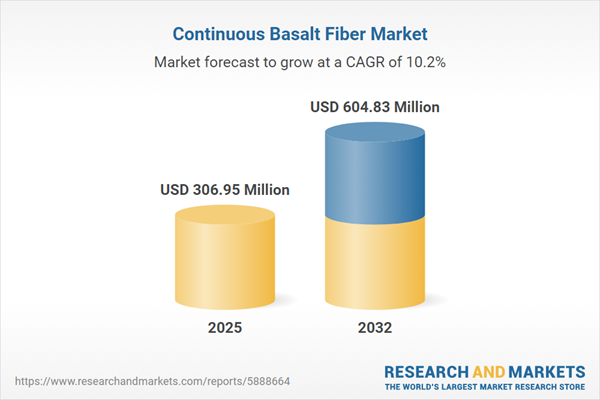Speak directly to the analyst to clarify any post sales queries you may have.
Continuous basalt fiber is increasingly central to sustainability-focused manufacturing and engineering, enabling companies to meet modern demands for durability, efficiency, and responsible sourcing. Senior leaders are evaluating this material for its operational resilience and ability to align with evolving supply chain and investment strategies.
Market Snapshot: Continuous Basalt Fiber Market Size and Growth Outlook
The global continuous basalt fiber market is on a strong growth trajectory, expanding from USD 277.96 million in 2024 to USD 306.95 million in 2025. By 2032, projections estimate it will total USD 604.83 million, reflecting a compound annual growth rate (CAGR) of 10.20%. This momentum is driven by increased adoption in sectors seeking reliable, lightweight, and environmentally resilient materials. Infrastructure, transportation, renewable energy, and industrial machinery companies identify continuous basalt fiber as a pivotal asset within their supply chains. Regulatory shifts, technical innovations, and evolving customer demands are transforming the competitive environment, positioning continuous basalt fiber as a priority for organizations focused on gaining and maintaining competitive advantage.
Scope & Segmentation: Strategic Applications and Industry Breadth
- Fiber Types: Chopped fiber, nonwoven and mat products, along with rovings and woven roving, cater to a range of durability, flexibility, and performance applications across construction, manufacturing, and composite solutions.
- End-Use Industries: Building and construction industries leverage continuous basalt fiber for reinforcement and roofing. The consumer goods sector benefits from its strength and reduced weight in applications such as furniture, sports equipment, and textiles. Wind energy solutions utilize it in both offshore and onshore projects for enhanced performance. Industrial equipment and the oil and gas sector value its compatibility with demanding operational environments. Within transportation—including aerospace, marine, shipbuilding, and automotive—continuous basalt fiber improves safety and structural performance.
- Regional Markets: The Americas, Europe, Middle East and Africa, and Asia-Pacific each feature distinct investment and adoption patterns, shaped by infrastructure needs, local legislative agendas, and procurement policies. Asia-Pacific is marked by major infrastructure initiatives and policy-driven adoption, whereas Europe prioritizes sustainability and regulatory compliance.
- Leading Companies Profiled: Influential market players include Kamenny Vek, Basaltex N.V., Basfiber S.L., Basalt Technology GmbH, Jiangxi Basalt Fibre Technology Co., Ltd., Hebei Baishili Basalt Fiber Co., Ltd., Suzhou Basalt Fibre Technology Co., Ltd., Lenobasalt LLC, Chongqing Basalt Fiber New Materials Co., Ltd., and Jiangsu Haicheng New Materials Technology Co., Ltd. These companies drive global adoption and technology development.
- Technologies and Innovations: Advancements such as microwave-assisted melting, advanced draw tower systems, and real-time quality monitoring have boosted production efficiency and process reliability. The industry increasingly integrates digital twin technologies and hybrid composites, accelerating the launch of new product classes and enabling enhanced process control.
Key Takeaways for Decision-Makers
- Adoption in sectors demanding chemical stability and fatigue resistance underscores continuous basalt fiber as a strategic choice for long-lasting, sustainable installations.
- Digital quality control and process automation are delivering waste reduction, higher output consistency, and resilient supply chains, fostering ongoing operational reliability.
- Value-added forms strengthen critical infrastructure and vehicles, delivering thermal and mechanical performance that boosts safety and asset lifespan under challenging use cycles.
- Strategic alliances and vertical integration are streamlining product innovation cycles, enabling agile responses to changing end-user needs and supporting product differentiation.
- Aligning procurement with regional and regulatory frameworks supports compliance and mitigates risk across varying jurisdictions for sustained competitive position.
- Circular economy models and lifecycle assessment are gaining prominence in supplier evaluation, integrating sustainability and risk parameters into sourcing strategies and deployment plans.
Tariff Impact: U.S. Tariffs Realign Competitive and Supply Chain Dynamics
The 2025 introduction of U.S. tariffs is redefining sourcing within the continuous basalt fiber market. Rising landed costs prompt businesses to form regional partnerships and intensify domestic production, providing greater adaptability amid a shifting trade environment. Flexible contracts and committed supplier engagement have proven important in maintaining reliable sourcing and mitigating supply disruptions.
Methodology & Data Sources
This report draws on structured interviews with industry thought leaders and incorporates secondary research from technical publications, corporate filings, patent reviews, and regulatory analyses. The approach triangulates insights, delivering actionable intelligence for executive-level planning and risk assessment.
Why This Report Matters
- Enables the identification of opportunities and risks throughout the continuous basalt fiber value chain, supporting informed investment and market decisions.
- Provides robust segmentation and regional intelligence, guiding procurement, strategy, and resource allocation.
- Equips organizations with recommendations on sustainability, partnership models, and technology adoption to support smooth transitions across industry shifts.
Conclusion
Continuous basalt fiber supports the development of resilient industrial strategies and long-term organizational value. The insights provided offer a foundation for proactive adaptation and sustainable growth in a changing global market.
Additional Product Information:
- Purchase of this report includes 1 year online access with quarterly updates.
- This report can be updated on request. Please contact our Customer Experience team using the Ask a Question widget on our website.
Table of Contents
3. Executive Summary
4. Market Overview
7. Cumulative Impact of Artificial Intelligence 2025
Samples

LOADING...
Companies Mentioned
The key companies profiled in this Continuous Basalt Fiber market report include:- Public Joint Stock Company "Kamenny Vek"
- Basaltex N.V.
- Basfiber S.L.
- Basalt Technology GmbH
- Jiangxi Basalt Fibre Technology Co., Ltd.
- Hebei Baishili Basalt Fiber Co., Ltd.
- Suzhou Basalt Fibre Technology Co., Ltd.
- Lenobasalt LLC
- Chongqing Basalt Fiber New Materials Co., Ltd.
- Jiangsu Haicheng New Materials Technology Co., Ltd.
Table Information
| Report Attribute | Details |
|---|---|
| No. of Pages | 192 |
| Published | October 2025 |
| Forecast Period | 2025 - 2032 |
| Estimated Market Value ( USD | $ 306.95 Million |
| Forecasted Market Value ( USD | $ 604.83 Million |
| Compound Annual Growth Rate | 10.2% |
| Regions Covered | Global |
| No. of Companies Mentioned | 11 |









